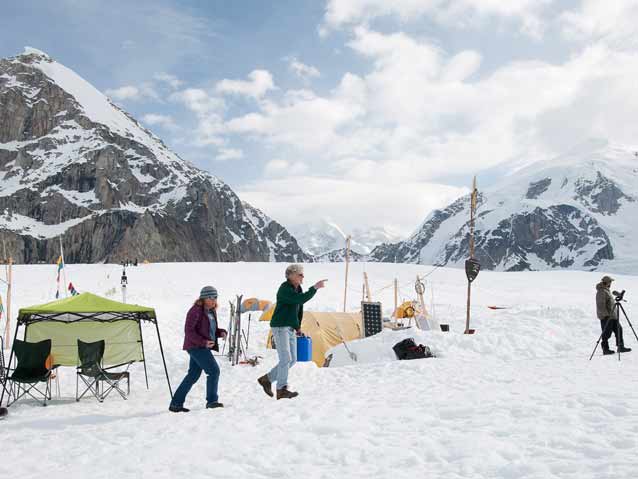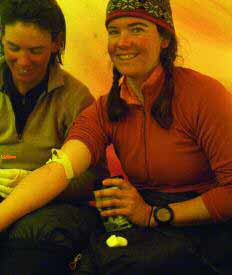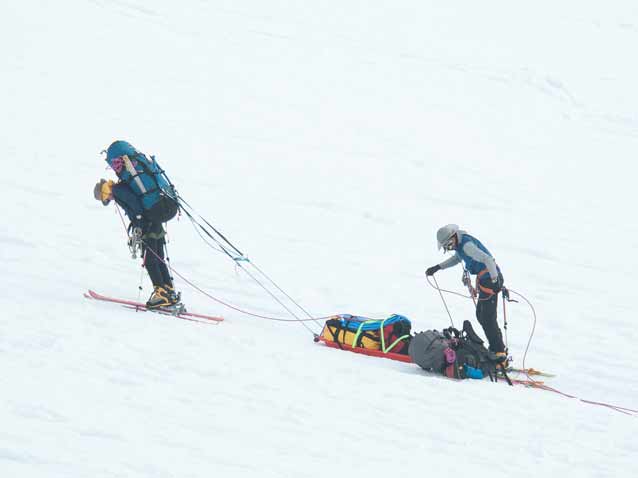
NPS Photo / Kent Miller
Late spring sunlight glows through a tent at the 14,200-foot (4328 m) camp. Dr. Caitlin Gustafson is taking 0.3 cc of blood from a climber who wears a wool hat, her turtleneck pushed up to the elbow, and a grin.
Dr. Clay Roscoe stands by, ready to insert a cuvette into a portable cooximeter that measures the amount of carboxyhemoglobin (COHb): carbon monoxide (CO) bound with hemoglobin in the blood. The level of COHb indicates exposure to CO from heaters or cooking stoves in poorly ventilated tents.
It is another day of research on the mountain.
Among those who ascend the slopes of Mount McKinley are physicians and health care professionals who conduct research on the common maladies of mountaineers—carbon monoxide exposure, frostbite, diarrhea, dehydration, and high altitude illness, which can plague even the fittest climber. These research projects are part survey (questioning climbers about activities or symptoms) and part assay (assessing chemical or physiological status from blood samples). Below are brief synopses of four of these studies.
Do Climbers Exposed to Carbon Monoxide Have Higher Risk of Acute Mountain Sickness?
The woman volunteering a blood sample in the first aid tent was one of 146 climbers that Roscoe and Gustafson, both of the Family Medicine Residency of Idaho, enlisted in 2004 to assess CO exposure risk in climbers (Roscoe et al.). To test the relationship between elevated COHb and Acute Mountain Sickness (AMS), Roscoe and Gustafson took blood samples in addition to asking climbers about exposure to CO, past history of AMS, and symptoms of AMS (headache, nausea, fatigue, dizziness, and sleeping difficulty).

Courtesy Clay Roscoe
The majority (97%) of climbers reported ventilating their cooking space, yet 18 climbers (13%) tested positive for CO exposure. While 20 climbers (13.7%) met the criteria for AMS, contrary to hypothesized results, there was no significant relationship between elevated COHb and AMS. However, Roscoe still thinks there may be an important link. Climbers with symptoms of AMS did report operating stoves longer than those without AMS, a finding that Roscoe thinks supports the hypothesis that some individuals who believe they have AMS may also be affected by CO exposure.
A result Roscoe was not expecting was that descending climbers had higher CO exposure compared to ascending climbers. These results raise questions about how long COHb persists in climbers at high elevations and if CO toxicity is cumulative while climbers are on Mount McKinley.
Another important result was that more than 75% of the climbing rangers who were tested had elevated COHb levels. The elevated COHb levels may be correlated with insufficient ventilation of tents or possibly with cumulative impacts from long intervals in tents. Although the study does not confirm causes, it does suggest hypotheses and future research needs.
What Are the Risk Factors for Getting Diarrhea While Climbing Mount McKinley?
Following reports of a possible outbreak of diarrheal illness among climbers on Mount McKinley in May 2002, epidemiologists from the Alaska Division of Public Heath flew to the Kahiltna Base Camp at 7,200 feet (2195 m) to conduct a survey of climbers. Their mission was to determine the extent of diarrhea and what factors put climbers at risk (McLaughlin et al. 2005).

NPS Photo / Kent Miller
Health workers learned that 27% of the 132 surveyed climbers experienced diarrhea after arriving on the mountain. At high camps with no latrine, 69% of climbers saw feces near their camp. More than 10% of climbers had defecated directly on snow, rather than using a waste disposal bag or latrine. Most climbers (78%) collected snow for consumption within 30 feet (9 m) of camp, and most (67%) rarely or never boiled their snow-water. In addition, about 30% of climbers rarely or never washed their hands with a disinfectant after defecating.
Based on the collected data, the factors that appeared to place climbers most at risk were spending eight or more days at the 17,200-foot (5243 m) camp, being a member of a climbing party in which at least one other person had diarrhea, and not receiving education about disease risk-reduction from a guide. The two most likely causes of infectious diarrhea among climbers were consumption of fecally-contaminated snow and lack of personal hygiene.
Are Levels of the Blood Serum Compound VEGF Correlated with AMS?
At high elevations, capillaries become leaky. As the leaking plasma fluids pool in the brain, the resulting headache is a key symptom of AMS. Above 10,000 feet (3048 m), severe pooling in the lungs causes High Altitude Pulmonary Edema, and persistent brain-swelling produces life-threatening High Altitude Cerebral Edema.

NPS Photo / Kent Miller
To explore how capillaries become leaky at high altitudes, Dr. Eric Nilles, then at Yale University School of Medicine, studied whether levels of a blood chemical believed to cause leakiness in vascular tissue (vascular endothelial growth factor or VEGF) was higher in climbers with AMS (Nilles 2005). In 2002, Nilles enlisted ascending climbers who had been accli-mating at 14,200 feet (4328 m). Climbers self-assessed whether they were experi-encing AMS, and their blood samples were tested for levels of plasma VEGF.
Of the 51 climbers recruited in the study, 14 experienced AMS. Climbers with AMS had higher levels of VEGF than non-AMS climbers (79 versus 58 m pg/mL), but the difference was not significant statistically. Nilles wonders if his study failed to show a significant relationship because the VEGF responsible for brain capillary permeability is an intra-cerebral VEGF and not the VEGF he sampled in venous blood.
Application of Mountain Research
Each of the approximately 1,200 mountaineers who attempt a summit of Mount McKinley each year is a potential subject for research on medical aspects of high altitude climbs. Research results are more than interesting to science. They lead to improvements in the health and safety of climbers and climbing rangers on the high peaks of Mount McKinley.
References
Denali Mountaineering Staff and Medical Advisors. 2005.
Mountaineering in Denali National Park and Preserve. National Park Service, Alaska.
King, Julianna. 2002.
Unpublished data, Alaska Family Practice Residency.
McLaughlin, Josepth B., Bradford D. Gessner, and Ann Marie Bailey. 2005.
Gastroenteritis outbreak among mountaineers climbing the West Buttress Route of Denali—Denali National Park, Alaska, June 2002. Wilderness and Environmental Medicine 16: 92-96.
Nilles, Eric. 2005.
Vascular Endothelial Growth Factor and Acute Mountain Sickness. Unpublished report.
Roscoe, Clay, Ed Baker, Caitlin Gustafson, Todd Arndt, and Jennifer Dow. In review.
Investigating carbon monoxide exposure on Denali. Submitted to Wilderness and Environmental Medicine.
Part of a series of articles titled Alaska Park Science - Volume 5 Issue 1: Scientific Studies in Denali.
Last updated: February 3, 2025
